Time loop games: so hot right now.
It seems a little harsh to lump The Forgotten City in with the rest of the me-too games that have started to crop up in response to Outer Wilds. For one thing it’s been in development in one form or another for far longer than any of its contemporaries, as it’s a standalone version of what was originally a Skyrim mod. For another, while it might make surprisingly poor use of the time loop concept, this is less of a problem for The Forgotten City than it is for, say, Deathloop, because The Forgotten City’s time loop is actually not the most eye-catching thing about it. It’s smart enough to give itself more than one gimmick, and the other thing it does is so utterly out there that you almost forget this is a time loop game at all.
The Forgotten City has you playing an explorer from the present day who is transported 2,000 years back in time to a strange Roman settlement that’s located entirely underground. The game keeps calling it a city, but if so it’s a very small one with just 23 residents. Or I should probably say it has 23 current residents, as no matter where you go in the city you’ll find that it’s also littered with dozens and dozens of golden statues, most of whom are frozen in various states of terror and anguish. These are the remains of the previous inhabitants, who fell foul of a strange rule that governs everyone who lives there: if anyone in the city commits a sin, no matter how small, the entire population is killed by being turned to gold, which is a curse somewhat wincingly referred to in-game as “The Golden Rule”.
This is an agreeably batshit premise for a game, and also about the level of crazy that would get me to buy and install anything that was so obviously trying to ape Skyrim. I said it before when I reviewed The Outer Worlds and I’ll say it again here: your game being based on (or ripped off from) a Gamebryo game doesn’t mean you have to treat the Gamebryo engine as a visual and technical target. The Forgotten City is built in the Unreal engine! Why does everyone have the glassy, emotionless eyes and sliding walking/running animations and the “ugh, guess I’ll stop what I’m doing and turn around to talk to you” animation preceding every single conversation? I suppose with The Forgotten City I can at least see the funny side of it, since the studio behind it has just three core developers and they’re going to go with what they know, and perhaps it’s even impressive in a way: this thing looks, sounds and behaves almost exactly like Skyrim does, and it must have taken a lot of effort to make it so.
There are some important differences, however. The city has the usual selection of pointless items that you can pick up and examine and even add to your inventory to no good purpose, like shrines and bread and Roman toilet paper. There’s a smaller subset of items that are actually useful (like money), however, and these have the usual Skyrim concept of ownership where taking them will be marked with a “Steal” action. But unlike Skyrim there’s no guards in The Forgotten City who will run up to you shouting “Stop right there, criminal scum!” should you be caught in the act of stealing; stealing is very much a sin here, and since you’re covered by the same punitive rule as everyone else attempting to take something that doesn’t belong to you will instead trigger a very localised version of the apocalypse. Everyone else in the city will die, and you only have a short amount of time to escape it yourself by throwing yourself into a magic time portal and looping back around to the start of the day.
This is the key difference between The Forgotten City and other time loop games like Outer Wilds: while the ones I’ve played so far totally reset the game on each loop through the guise of transporting only the player’s memories back in time, The Forgotten City transports the entire player. This means that anything that was in your inventory at the end of one loop is still there at the start of the next one, which opens up some interesting possibilities with regard to e.g. duping items that, alas, remain totally unexplored. Instead you leverage this version of the time loop in exactly the way that it first appears: as a method of obtaining items that are otherwise protected by that big red “STEAL” label. You can actually pick up every single stealable item in one go on the first loop, once you’ve spent a couple of hours exploring the city, scoping out their locations and planning your escape route; you have enough time to do this in between stealing the first one and being turned to gold yourself, and once you have them all you’ll find a lot of the quests and puzzles in the game to be startlingly easy.
This one concept — that stealable items can be obtained by stealing them and then looping with them — is the only time-travel-y thing that The Forgotten City asks you to understand, and is basically all that the time loop is used for; you can only loop once a sin is committed and The Golden Rule is broken, but it turns out that pretty much the only reliable way of triggering this is to steal something, since the city’s inhabitants quite wisely took the precaution of throwing all of their weapons into a deep chasm and there are no other “sins” codified in the gameplay mechanics. Time does appear to pass during a single loop as people move around the city during the day, some characters die if you don’t intervene, and eventually, at the end of it, one of them ends up breaking The Golden Rule themselves and forces you back to the start. Aside from this, though, the loop is curiously inconsequential; nearly all actions and events in The Forgotten City are player-triggered rather than time-triggered, and while some of those events do require knowledge that was picked up on previous loops in order to save certain characters before they expire, it’s still a rather disappointing incorporation of the time loop concept.
So, since the time loop is something of a bust, The Forgotten City is left to live or die as the thing it most strongly resembles: a regular first-person adventure game. Here, at least, it shows some backbone. I was a little less taken with its cod-philosophical discussions around what constitutes a sin than I suspect the writers thought I would be, largely because I remember having almost exactly the same debate with my RE teacher when I was 12. The story leans heavily on Roman and Greek mythology and The Forgotten City is well-versed in the fine detail of Roman society, and this too might have been more impressive if I had played literally no other videogames ever; as things stand it’s an extremely thoroughly-mined setting and I’d seen most of it before, but that’s not particularly The Forgotten City’s fault.
What it does do well, though, is use The Golden Rule to create a constant sense of omnipresent dread. No matter where you go in the city, you’re constantly reminded that this is a community with the Sword of Damocles hanging over it. Those golden statues are everywhere, and from the poses they’ve been frozen in you can tell that most of these people did not die well. Some of them will whisper to you from time to time, which is both a bit creepy and also functions as the game’s hint system. Occasionally you’ll hear a grinding noise as the head of one or more statues turns to face you; they are also watching you, it seems. The outwardly-bizarre premise of The Golden Rule is the most interesting thing about The Forgotten City by some considerable distance, and it tries to leverage that weirdness for all that it’s worth; occasionally it makes a misstep, as it does with an extremely ill-advised segue into horror about halfway into the game, but mostly it succeeds in projecting this feeling of eerie wrongness without becoming properly oppressive the way something like Pathologic 21 does.
And for all that I slated its take on the time loop concept, The Forgotten City does at least seem to understand the value of reactivity and branching narrative. Going through the same conversation tree on successive loops is often not necessary, as the game will offer you a “Let’s skip to the point” dialogue option. If you start a new loop and go and talk to someone you got a quest objective from on a previous loop, you can short circuit the entire quest chain up to that point and just give them the thing that they asked for. They’ll respond with a bit of a hand-wavy “Oh, uh, I don’t know how you know I’d need that, but thanks anyway!” voice line, but in general The Forgotten City is extremely good at not wasting the player’s time by making them pointlessly repeat things they already did on previous loops — later on you can even ask someone to go off and complete entire quest chains that you know the solution for on your behalf, while you yourself get on with the actually new stuff. And the really nice thing about this is that the game doesn’t just set the completion flags for those quests to TRUE, he’ll actually go off and do them in real-time! If you follow him around the city while he does so you’ll see that he’s got custom dialogue for them too; it’s a great little touch that, while a tad artificial — why is this guy just unquestioningly following orders from a person he’s never met before? — is very respectful of the player’s time. And since I happen to value my time quite highly, it means I’m considerably better disposed towards The Forgotten City’s otherwise wasteful use of the time loop than I was Deathloop’s. At least The Forgotten City didn’t make it onerous.
Regarding that branching narrative: the end goal of The Forgotten City is to escape the city, and the game provides several ways of doing this. The intended one is that you spend a few hours talking to everyone, solving their problems and building up enough backstory to uncover the truth behind The Golden Rule, and eventually free both you and everyone else from its grasp. There are alternate ways of getting out, however, two of which are signposted pretty prominently on the critical path (in fact most people are probably going to hit one of the alternates before reloading to get the true, canon ending), but the last is pretty sneaky and is the one thing in the game that actually leverages the time loop in a halfway-imaginative fashion; it’s just a shame that it’s relegated to what is effectively a “secret” ending for the game that only a minority of players will end up seeing. There’s also a fair chunk of optional dialogue and questlines that give you more context on the motivations of various people in the city which, while it may not change the ultimate outcome of the game, will drastically change your perception of the game, This material doesn’t feel extraneous the way Deathloop’s optional content did; it’s well worth exhausting everything in your quest log before finishing the game, and then going around and talking to everyone one last time, as this is the only way you’ll get the full picture of what’s going on.
I think that The Forgotten City has benefited greatly from two things here. One is that I knew practically nothing about it going in except for the Roman theming, The Golden Rule and that it involved time travel in some way. Since I had no expectations2 it was very difficult to be disappointed with what I got: a competent and pleasantly reactive yet otherwise largely unexceptional adventure game. The other is that I probably would have gone in rather harder on The Forgotten City’s failings around the use of its time loop regardless, if I hadn’t very recently also played Deathloop. Both games fumble the idea badly in terms of mechanics and puzzle solutions, but The Forgotten City’s take on it is at least better than Deathloop’s, with multiple paths through the game possible and even a few meaningful secrets to find. Ultimately neither game can hold a candle to the spectacular Outer Wilds3; however, The Forgotten City has a bit more to offer than just its time loop, and so if you think of it as an adventure game rather than a time loop game then it’s a perfectly respectable way to spend 6-7 hours of your time.
- Which I still haven’t played beyond the first hour because I really need to be in the right frame of mind for it. ↩
- Although I was expecting rather more from a game with a 97% positive rating on Steam. ↩
- And to be completely fair to both games even Outer Wilds has trouble doing this, as its recent underwhelming DLC expansion proved. ↩

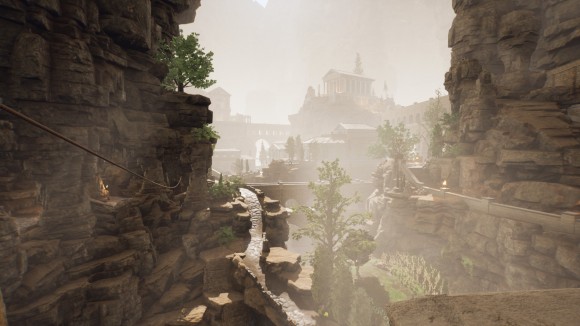
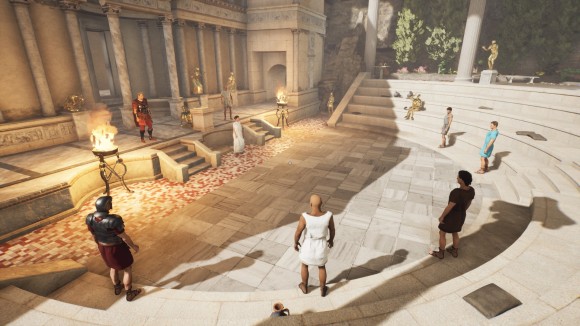
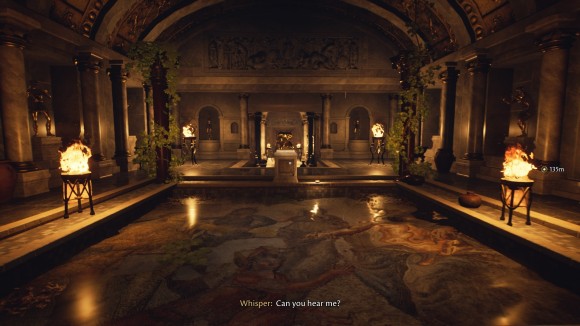
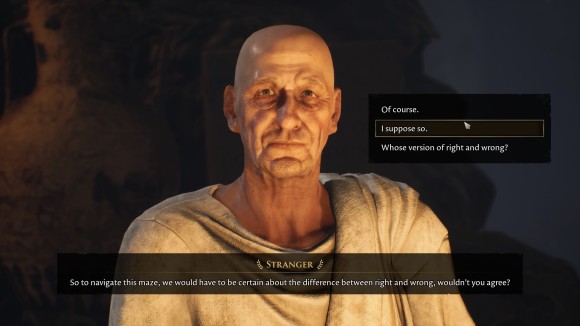
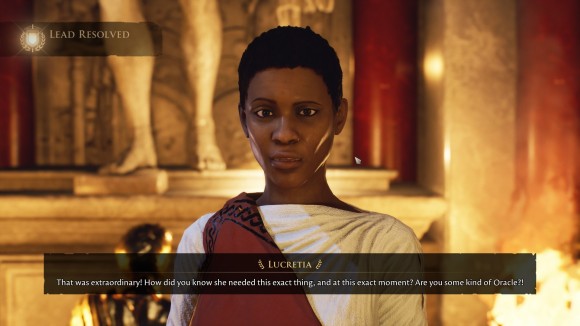
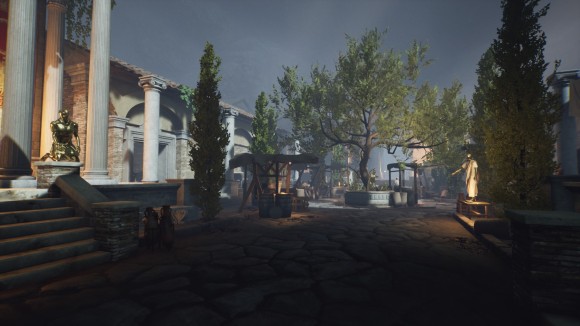
I liked the mod and liked the game. It reminded me the Last Express game. It’s very much a historical game and it’s about doing things in the right sequence to get specific results.
It’s surprising how small it is. You mention they didn’t do much with time and I can’t imagine how much restraint they needed. It’s very obvious they wanted the game to be very easy to understand, everything is overexplained and devs don’t require you to know who are Sisyphus or Seneca. You mention Pathologic 2 and I’d say it’s a version of Pathologic 2 that doesn’t want players to suffer. So they’ve made this cool storytelling engine but the game itself is very small. And a lot of it is a single action segment that felt like a leftover from Skyrim. Strange they’ve left this thing in instead of doing more complicated time-related things.
Anyway, have to respect the restraint. I see many games praised for the ambition even if the execution is poor (like the previous game you’ve reviewed) and I’m tired of good ideas executed badly. The Forgotten City still has some parts that don’t quite work (the game doesn’t take into account a lot of combinations of events and NPCs do not react to things you’d expect them to react to) and I think it would work better as a much smaller game. Would it lost much if it only had a little voice-over and play like a top-down adventure game? Would certainly not take as much time to develop.
All of this is true, I think. The Skyrim lineage is funny to see manifested in a completely different engine, but did the game really gain anything from being a first-person adventure with terrible combat? In this case I think it *was* actually the development option requiring the least amount of effort because it meant they had to do a minimum amount of retooling from the mod, but if you were approaching this idea fresh I don’t think it would be at the top of your list of interface options.
And yes, it’s fine for a game to simply be okay. I play way too many games and I like to be challenged and surprised and it’s increasingly difficult to find games that will do that, which is why I valued WotR so highly. I’ll never slate a game for showing restraint and setting its sights a little lower, though, if only because I’m more likely to not play it all if that’s the case.